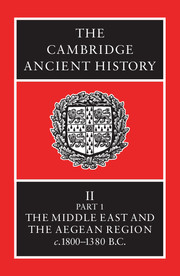Book contents
- Frontmatter
- Contents
- List of Maps
- List of Tables
- List of Text-figures
- Preface
- CHAPTER I NORTHERN MESOPOTAMIA AND SYRIA
- CHAPTER II EGYPT: FROM THE DEATH OF AMMENEMES III TO SEQENENRE II
- CHAPTER III PALESTINE IN THE MIDDLE BRONZE AGE
- CHAPTER IV
- CHAPTER V HAMMURABI AND THE END OF HIS DYNASTY
- CHAPTER VI ANATOLIA c. 1750–1600 B.C.
- CHAPTER VII PERSIA c. 1800–1550 B.C.
- CHAPTER VIII EGYPT: FROM THE EXPULSION OF THE HYKSOS TO AMENOPHIS I
- CHAPTER IX EGYPT: INTERNAL AFFAIRS FROM TUTHMOSIS I TO THE DEATH OF AMENOPHIS III
- CHAPTER X SYRIA c. 1550–1400 B.C.
- CHAPTER XI PALESTINE IN THE TIME OF THE EIGHTEENTH DYNASTY
- CHAPTER XII THE ZENITH OF MINOAN CIVILIZATION
- CHAPTER XIII THE LINEAR SCRIPTS AND THE TABLETS AS HISTORICAL DOCUMENTS
- CHAPTER XIV THE RISE OF MYCENAEAN CIVILIZATION
- CHAPTER XV ANATOLIA c. 1600–1380 b.c.
- CHAPTER XVI THE ARCHAEOLOGICAL EVIDENCE OF THE SECOND MILLENNIUM B.C. ON THE PERSIAN PLATEAU
- BIBLIOGRAPHIES
- Chronological Tables
- Index to Maps
- General Index
- Map 1: Greece and the Aegean Islands in the Middle Bronze Age.
- Map 3: Babylonia and Western Persia.
- Fig. 7. Plan of the Palace at Cnossus.
- Map 6: Ancient Asia Minor and Northern mesopotamia
- References
CHAPTER VIII - EGYPT: FROM THE EXPULSION OF THE HYKSOS TO AMENOPHIS I
Published online by Cambridge University Press: 28 March 2008
- Frontmatter
- Contents
- List of Maps
- List of Tables
- List of Text-figures
- Preface
- CHAPTER I NORTHERN MESOPOTAMIA AND SYRIA
- CHAPTER II EGYPT: FROM THE DEATH OF AMMENEMES III TO SEQENENRE II
- CHAPTER III PALESTINE IN THE MIDDLE BRONZE AGE
- CHAPTER IV
- CHAPTER V HAMMURABI AND THE END OF HIS DYNASTY
- CHAPTER VI ANATOLIA c. 1750–1600 B.C.
- CHAPTER VII PERSIA c. 1800–1550 B.C.
- CHAPTER VIII EGYPT: FROM THE EXPULSION OF THE HYKSOS TO AMENOPHIS I
- CHAPTER IX EGYPT: INTERNAL AFFAIRS FROM TUTHMOSIS I TO THE DEATH OF AMENOPHIS III
- CHAPTER X SYRIA c. 1550–1400 B.C.
- CHAPTER XI PALESTINE IN THE TIME OF THE EIGHTEENTH DYNASTY
- CHAPTER XII THE ZENITH OF MINOAN CIVILIZATION
- CHAPTER XIII THE LINEAR SCRIPTS AND THE TABLETS AS HISTORICAL DOCUMENTS
- CHAPTER XIV THE RISE OF MYCENAEAN CIVILIZATION
- CHAPTER XV ANATOLIA c. 1600–1380 b.c.
- CHAPTER XVI THE ARCHAEOLOGICAL EVIDENCE OF THE SECOND MILLENNIUM B.C. ON THE PERSIAN PLATEAU
- BIBLIOGRAPHIES
- Chronological Tables
- Index to Maps
- General Index
- Map 1: Greece and the Aegean Islands in the Middle Bronze Age.
- Map 3: Babylonia and Western Persia.
- Fig. 7. Plan of the Palace at Cnossus.
- Map 6: Ancient Asia Minor and Northern mesopotamia
- References
Summary
THE CAMPAIGNS OF KAMOSE
The literary tradition of the New Kingdom, represented by the Story of Apophis and Seqenenre, suggests that the clash between the Hyksos and the native Egyptian kings of the Seventeenth Dynasty occurred in the reign of Seqenenre (II ?), as the result of deliberate provocation on the part of the Hyksos ruler. The first sentences of the story tell the condition of Egypt at the time: Seqenenre rules in the Southern City (Thebes), while Apophis rules in Avaris; the whole of Egypt pays tribute to the Hyksos. Egypt is described as a divided land, and there is no suggestion that the whole of Egypt is occupied by the Asiatics. The evidence in support of a total occupation is slender and inconclusive; even the famous description of Hyksos devastation in the inscription of Hatshepsut in the Speos Artemidos specifies only that ‘the Asiatics were in Avaris in the Northland, roving foreigners being in the midst of them’.
It is generally assumed that the lost portion of this story described a struggle between the Hyksos and the Egyptians, the outcome of which may have been a limited victory for the Egyptians. It is also assumed that Seqenenre was killed in the course of this struggle, the evidence in support of this assumption being the shattered skull of the king's mummy. The fragmentary beginning of a New Kingdom romance is, however, an uncertain foundation on which to build an historical edifice.
- Type
- Chapter
- Information
- The Cambridge Ancient History , pp. 289 - 312Publisher: Cambridge University PressPrint publication year: 1973
References
- 3
- Cited by



